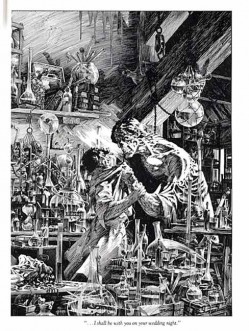THE TRANSHUMANISM SCRAPBOOK: RESEARCHERS WORKING ON UPLOADING PERSONAL ...  ~ hehe if "they" would just go UP 2 the N~Pole & geet an 'interview' wit the good Herr Dr. (if "they" could geet 'his' fucking monster 2 STOP chas~in His ass 'round ) Lol ..perhaps He/Herr Dr. ...could shed some light on the WHOLE ...thing ? Hehe oh Dr. ? gooooood Dr. ?? ....
~ hehe if "they" would just go UP 2 the N~Pole & geet an 'interview' wit the good Herr Dr. (if "they" could geet 'his' fucking monster 2 STOP chas~in His ass 'round ) Lol ..perhaps He/Herr Dr. ...could shed some light on the WHOLE ...thing ? Hehe oh Dr. ? gooooood Dr. ?? ....
The dream - or nightmare - is fast becoming a reality as this article shared by Ms. S.H. indicates:
Researchers Working on Technology to Bring Dead Back to Life
As we also pointed out in our book, the transhumanist agenda relies upon four basic technologies called the GRIN technologies - genetics, robotics, information technology, and nanotechnology - in various combinations, and that indeed is what is being done here:
Humai, a technology company based in Los Angeles, says that it is working on a project known as “Atom & Eve” that would let human consciousness be transferred to an artificial body after their death.And all this in turn to be accomplished by the cryogenic freezing of an individual's brain, for transplant into a new robotic body and "reactivation" when the time is right:
Artificial intelligence, the most important and major discovery of science will be one of the most helpful things in the whole project. The Humai have already started working on human rebirth using artificial intelligence.
The three technologies collectively used by the tech giant company are “Nanotechnology, bionics & artificial intelligence”. The company is expecting the whole system to be ready in 3 decades and, of course, this type of work requires this much time.
The tech company further says that the cloning technology of science will be able to restore the brain as it matures. Their vision on their website is “Humai is an AI company with a mission to reinvent the afterlife. We want to bring you back to life after you die.”As we pointed out in our book however, all this is based on the implicit assumption that the brain is the locus of the mind and personality, and that, indeed, the sum total of one's memories sums up to the person itself, a proposition which I personally find dubious, for built into this proposition is that when the body-brain dies, personhood itself dies with it. The notion is common to much science, but is somewhat of a novelty, and a very recent on at that, in the history of human thought, philosophy and religion. I suspect that eventually even if such technologies come online and prove superficially "successful," that soon people will discover that these "artifically-extended" personalities will lack something - perhaps inchoate and unformulable - and that this lack will indicate that not all of such an individual has been captured and extended. If that happens, the problems inherent with a purely materialistic basis for the understanding of mind, consciousness, or personhood will be exposed. What might be preserved by such means, in other words, is a similacrum of the person, a persona, not a person.
While talking to Australian Popular Science Bocanegra said that the brain of the dead will be frozen using cryonics technology and when their technology is fully developed and ready, they will embed the frozen bone back but into an artificial body which would be fully capable of living as the deceased used to.
There's something else I've pointed out before, and that is the opposite danger: that such techniques might work in toto, causing the "virtually immortal" individual to grow tired and weary of life, a weariness that might manifest itself in increasingly sociopathic behaviors: what value has life if everyone is immortal, and can "cheat" death technologically? With such "virtual immortality" also comes the possibility of a vast expansion of human knowledge, an expansion that, coupled with possibly increasingly psychotic behaviors, could rip society apart in apocalyptic paroxysms. And should such a technology be open to all? The rich and powerful will surely be the first with access to it, and indeed I've raised the high octane speculative possibility that some aspects of it may already be in their grasp, given the longevity of some of them. The rich and powerful have a kind of unique class disregard for humanity which they hide behind pseudo-philanthropic trusts and foundations. How does one prevent the technology from proliferating and falling into the wrong hands: do we want to see ISIS with it? Hitler? Stalin? Mao? Notably, when one looks at such transhumanist companies and their goals, one never finds any deep consideration - or any consideration, deep, shallow, or otherwise - of such moral and social issues. And the necessity of debate and discussion is every bit as necessary and important here as it is with other issues - cloning, genetic modifications, and so on - if not much more so.
No comments:
Post a Comment